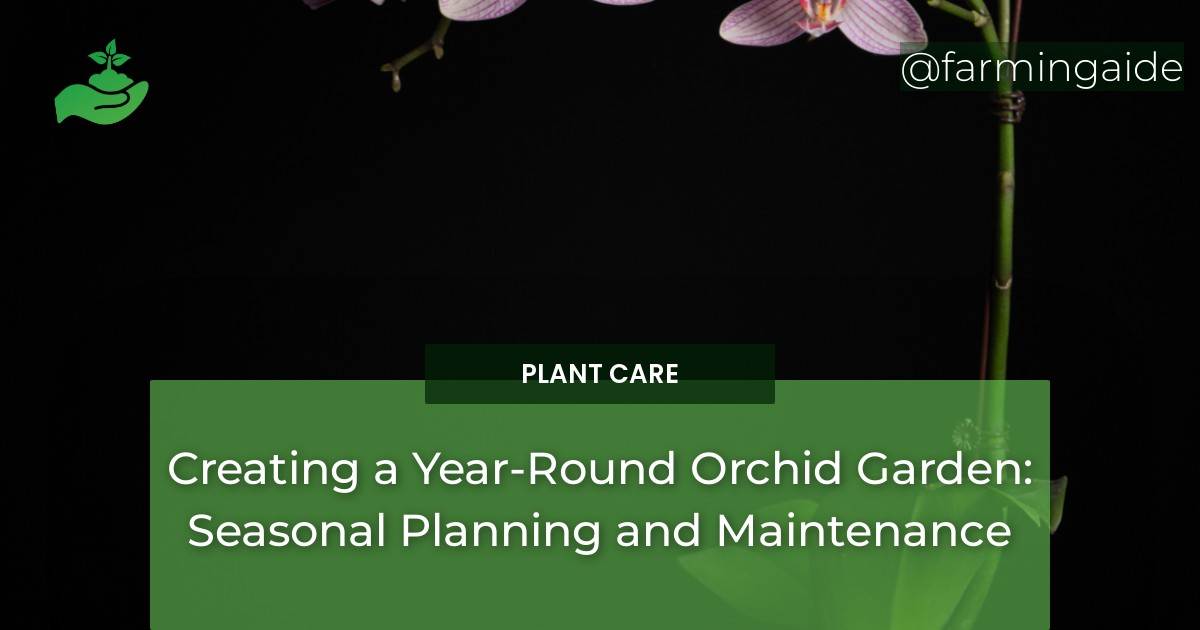Welcome to the world of orchid gardening, where beauty and elegance meet sustainability and seasonality. Orchids are one of the most coveted and beloved plants in the horticulture industry, known for their stunning blooms and delicate features. However, creating a year-round orchid garden requires more than just a love for these plants. It requires strategic planning and proper maintenance to ensure healthy growth and continuous blooms. In this comprehensive article, we will delve into the importance of seasonal planning and maintenance in orchid gardening, as well as provide tips and techniques for successful orchid care. So let’s get started on creating a year-round orchid garden that will be the envy of all your neighbors!
Importance of Seasonal Planning and Maintenance in Orchid Gardening
Orchids are not your typical garden plants. They require specific growing conditions and care to thrive, making seasonal planning and maintenance crucial for their success. By understanding the different seasons and their impact on orchids, you can ensure that your garden is always in bloom and your plants are healthy and happy.
Plant Selection and Cultivation
Choosing the right orchid varieties for your year-round garden is the first step towards success. With over 28,000 species of orchids, it can be overwhelming to decide which ones to include in your garden. However, by considering factors such as bloom time, light and temperature requirements, and growth habits, you can select the perfect orchids for your garden.
Once you have chosen your orchids, it is essential to understand their optimal growing conditions. Orchids thrive in well-draining, aerated soil with good moisture retention. They also require specific light and temperature levels, depending on the variety. Proper planting techniques, such as using a well-draining potting mix and providing adequate support for the plant, are also crucial for healthy growth.
Soil Management and Composting
High-quality soil is essential for the success of any garden, and orchids are no exception. Orchids require a well-aerated and nutrient-rich soil to thrive. Composting is an excellent way to improve the quality of your soil and provide your orchids with the necessary nutrients. By using organic materials such as leaves, grass clippings, and kitchen scraps, you can create a sustainable and nutrient-rich compost for your orchids.
Pest and Disease Control
Like any other plant, orchids are susceptible to pests and diseases. Common pests in orchids include aphids, mealybugs, and spider mites, while diseases such as root rot and fungal infections can also occur. Prevention is key in controlling pests and diseases in orchids. Regular monitoring and proper cultural practices, such as maintaining good air circulation and avoiding overwatering, can help prevent infestations. If an issue does arise, there are various treatment strategies available, including natural and chemical options.
Sustainable Gardening Practices
Incorporating sustainable practices in your orchid garden not only benefits the environment but also helps maintain a healthy and thriving garden. Water conservation techniques, such as using a drip irrigation system and collecting rainwater, can reduce water usage and save money. Natural pest control methods, such as introducing beneficial insects and using organic pest control products, can also help maintain a balance in your garden without harming the environment.
Seasonal Planning for Year-Round Blooms
To achieve continuous blooms in your orchid garden, it is essential to plan your planting and maintenance tasks according to the different seasons. The best times to plant orchids vary depending on the variety, but generally, spring and fall are ideal for most orchids. By choosing orchid varieties that bloom in different seasons, you can ensure that your garden is always in bloom. Seasonal maintenance tasks, such as repotting and fertilizing, are also crucial for the health of your orchids.
Crop Rotation for Continuous Blooms
Crop rotation is a common practice in agriculture, but it can also be beneficial in orchid gardening. By rotating your orchids, you can ensure that they receive the necessary nutrients and avoid soil depletion. It also allows you to change the location of your orchids, which can help prevent pests and diseases. Considerations for different growing conditions, such as light and temperature, should also be taken into account when rotating your orchids.
How Can Eco-Friendly Practices be Incorporated into Year-Round Orchid Garden Maintenance?
Incorporating sustainable orchid gardening practices into year-round maintenance is essential for minimizing environmental impact. Utilize organic fertilizers, conserve water through drip irrigation, and opt for natural pest control methods. Recycle materials for garden infrastructure and consider implementing composting to reduce waste. Prioritizing eco-friendly practices ensures a thriving orchid garden while minimizing harm to the planet.
Conclusion
Creating a year-round orchid garden requires strategic planning and proper maintenance. By understanding the importance of seasonal planning and implementing sustainable gardening practices, you can ensure that your orchids thrive and provide continuous blooms. With the right plant selection, soil management, pest and disease control, and crop rotation, your orchid garden will be a beautiful and sustainable oasis that you can enjoy all year round.


